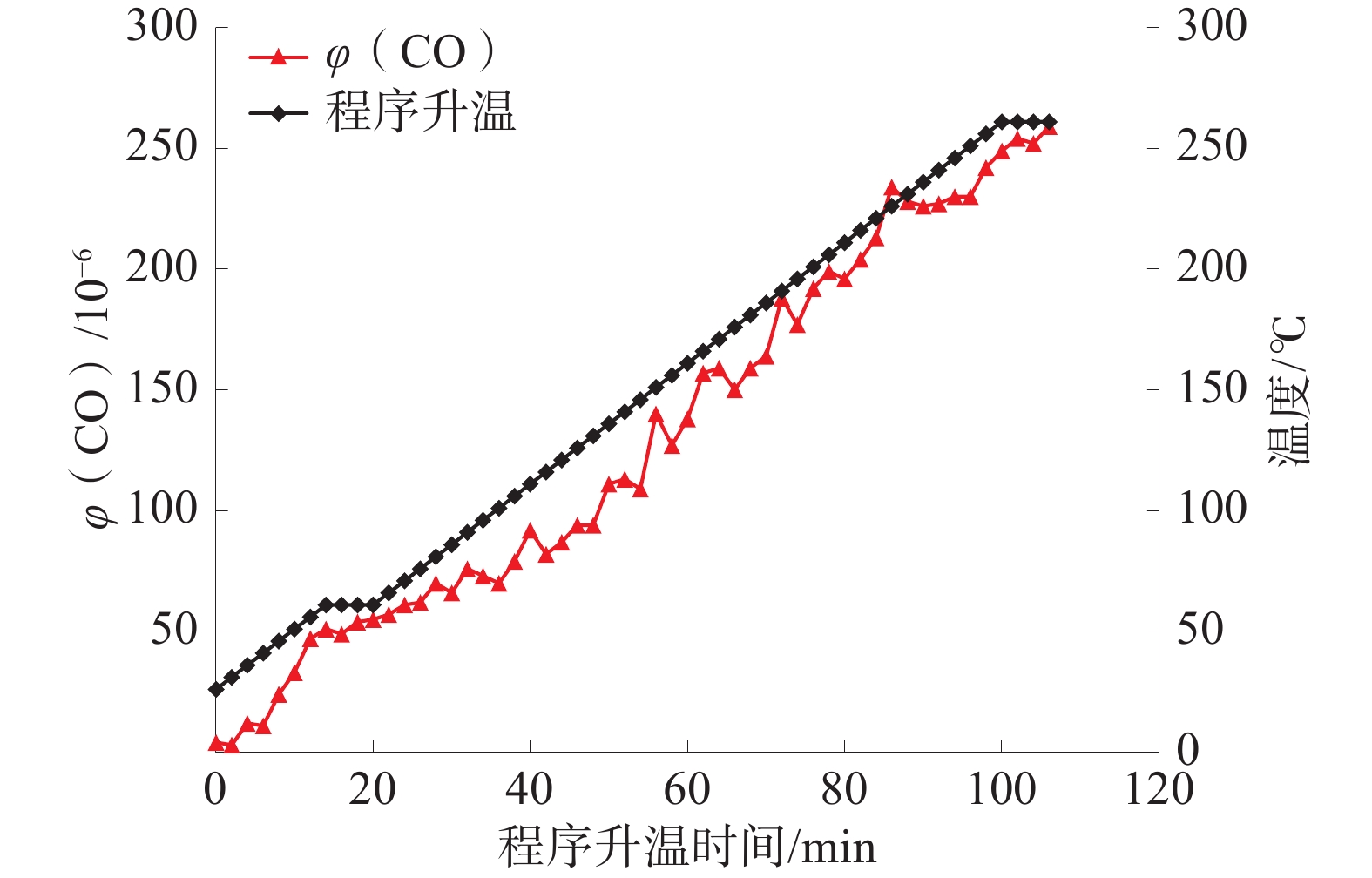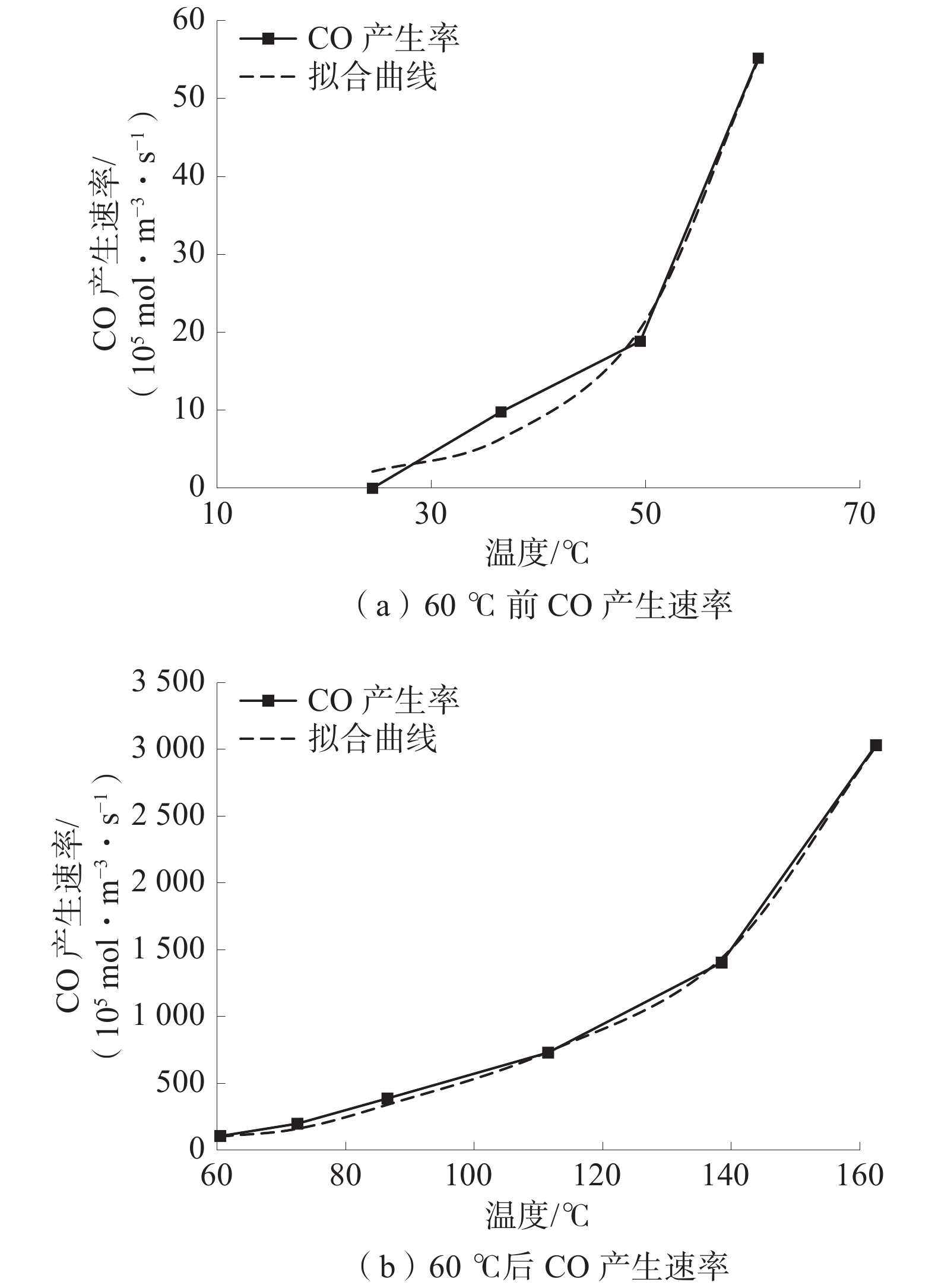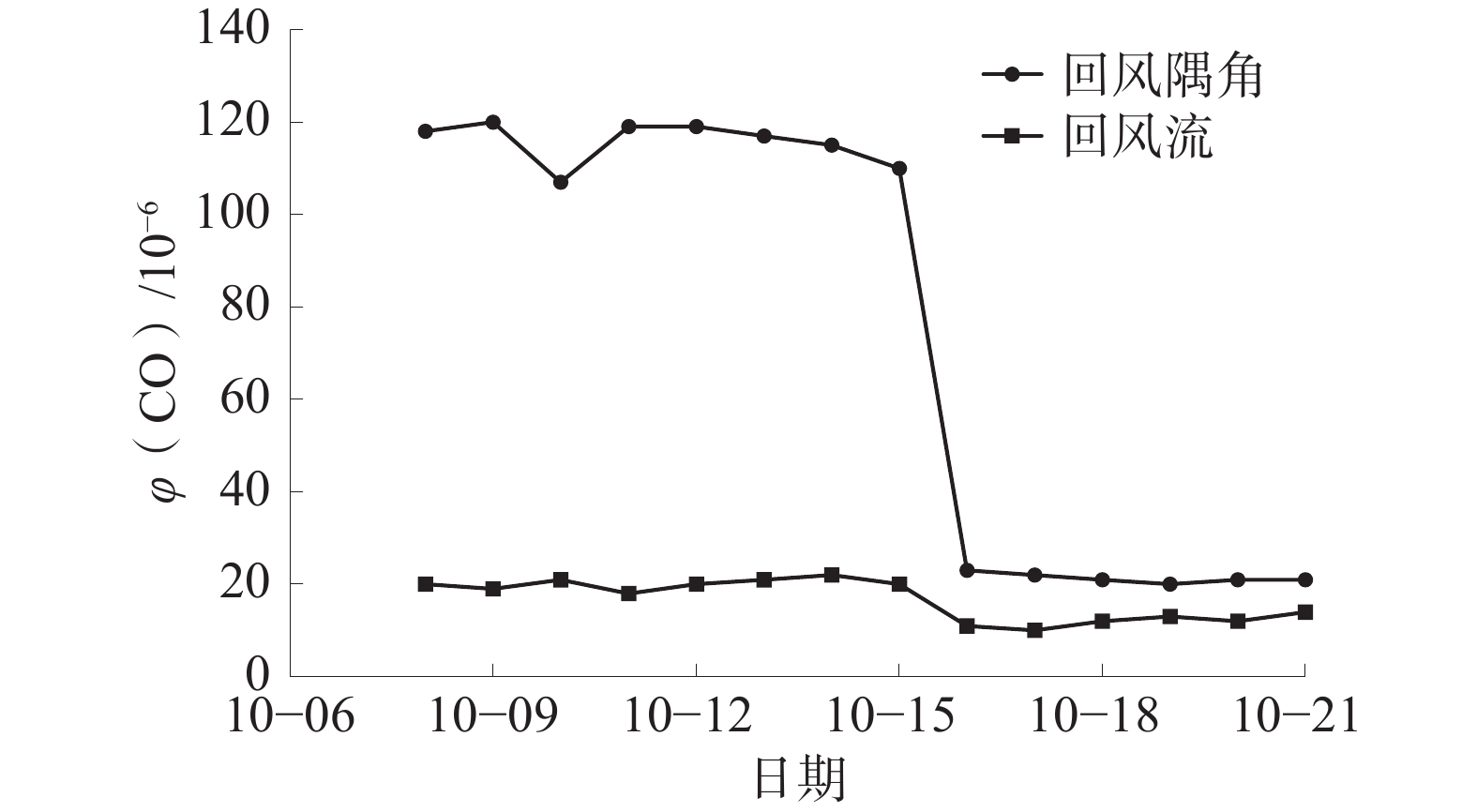Study on CO source and control technology of low metamorphic coal
-
摘要:
为了研究低变质煤CO来源,降低煤层自然发火风险;以大南湖一矿3#煤层为研究对象,通过程序升温实验、实验模拟及现场观测等手段,研究3#煤层CO赋存、开采及割煤中CO产生规律及回风隅角CO来源占比等规律。结果表明:煤在无氧下粉碎,煤分子共价键断裂生成的大量官能团、自由基相互作用产生极少量CO;煤在有氧下粉碎,产生大量CO,随煤样比表面积增大,CO体积分数随之增加并最终趋于稳定;采煤机割煤中产生高温使煤体发生氧化产生CO体积分数为(30~50)×10−6;回风隅角CO来源于采空区的CO体积分数占回风隅角CO总体积分数的28%,70%以上的CO来源于生产时期后溜破碎煤体氧化。根据低变质煤CO来源,采取了有针对性的架后喷洒CO复合抑制剂、采空区压注冷氮及漏风封堵等综合防控措施,使回风隅角及回风流CO体积分数大幅降低。
Abstract:In order to explore the source of low metamorphic coal CO source and reduce the risk of natural fire in the coal seam, Taking the 3# coal seam of Dananhu No.1 mine as the research object, the CO generation rule in the CO occurrence, mining and cutting of the 3# coal seam and the CO source ratio in the corner of the return air are studied by means of temperature programming experiment, experiment simulation and field observation. The results show that when coal is pulverized without oxygen, a large number of functional groups and free radicals generated by the covalent bond fracture of coal molecules interact to produce a very small amount of CO. When coal is pulverized under oxygen, a large amount of CO is produced. With the increase of specific surface area of coal samples, the volume fraction of CO increases and eventually becomes stable. The coal cutting machine produces high temperature, which oxidizes the coal body and produces CO volume fraction of 30−50 ppm. The CO from the goaf accounts for 28% of the total integral number of the CO from the return air corner, and more than 70% of the CO comes from the oxidation of the crushed coal after the production period. According to the CO source of low metamorphic coal, comprehensive prevention and control measures such as spraying CO compound inhibitor after the frame, pressure injection of cold nitrogen in goaf and air leakage plugging have been taken to reduce CO volume fraction in return air corner and return air flow significantly.
-
-
表 1 钻孔施工参数
Table 1 Drilling parameters
编号 开孔
高度/m方位角/
(°)倾角/
(°)孔深/
m孔径/
10−3m封孔长
度/m注气 1 1.7 230 5 27.5 94 10 氮气 2 1.7 140 5 31.0 94 10 空气 3 1.7 250 3 40.0 94 10 空气 4 1.7 120 5 36.0 94 10 氮气 表 2 钻孔内CO分析数据
Table 2 CO analysis data in boreholes
日期 $\varphi $(CO)/10−6 1# 2# 3# 4# 12-26 7 86 128 8 12-27 5 92 110 8 12-28 6 100 90 6 12-29 5 96 100 7 12-30 4 104 98 6 12-31 4 87 88 5 01-01 4 92 84 5 01-02 3 78 72 4 01-03 2 72 84 3 01-04 2 93 83 2 01-05 1 86 72 1 01-06 0 84 77 0 01-07 0 73 67 1 01-08 0 65 54 0 01-09 1 65 56 0 表 3 煤无氧粉碎前后比表面积及CO体积分数统计表
Table 3 Statistical table of specific surface area and CO concentration before and after anaerobic crushing of coal
煤样 粉碎时
间/min粉碎前CO
体积分数/
10−6粉碎后CO
体积分数/
10−6粉碎前比
表面积/
(m2·g−1)粉碎后比
表面积/
(m2·g−1)1# 0 0 0 2.323×10−5 2.323×10−5 2# 1 0 1.97 2.322×10−5 0.21637 3# 3 0 2.72 2.355×10−5 2.39487 4# 5 0 2.87 2.419×10−5 2.93461 5# 7 0 2.83 2.427×10−5 3.18186 表 4 煤有氧破碎前后比表面积及CO浓度统计表
Table 4 Statistical table of specific surface area and CO concentration before and after aerobic crushing of coal
煤样 粉碎时
间/min粉碎前CO
体积分数/
10−6粉碎后CO
体积分数/
10−6粉碎前比
表面积/
(m2·g−1)粉碎后比
表面积/
(m2·g−1)6# 0 1.57 2 2.423×10−5 2.423×10−5 7# 1 1.37 102 2.431×10−5 0.23688 8# 3 1.18 261 2.422×10−5 2.44359 9# 5 1.46 343 2.435×10−5 3.66444 10# 7 1.44 350 2.426×10−5 3.71177 -
[1] 薛冰,李再峰,陈兴权,等. 低阶煤在干燥氧气下低温氧化过程的机理研究[J]. 煤炭转化,2006(2):12−15. doi: 10.3969/j.issn.1004-4248.2006.02.004 XUE Bing, LI Zaifeng, CHEN Xingquan, et al. Mechanism of low temperature oxidation of low rank coal under dry oxygen[J]. Coal Conversion, 2006(2): 12−15. doi: 10.3969/j.issn.1004-4248.2006.02.004
[2] 戚绪尧. 煤中活性基团的氧化及自反应过程[J]. 煤炭学报,2011,36(12):2133−2134. QI Xuyao. Oxidation and self-reaction of active groups in coal[J]. Journal of China Coal Society, 2011, 36(12): 2133−2134.
[3] 邓存宝,王继仁,张俭,等. 煤自燃生成乙烯反应机理[J]. 煤炭学报,2008,33(3):299−303. DENG Cunbao, WANG Jiren, ZHANG Jian, et al. Reaction mechanism of ethylene production during spontaneous combustion of coal[J]. Journal of China Coal Society, 2008, 33(3): 299−303.
[4] 杨广文,艾兴. 大雁二矿250综采工作面CO来源的分析及治理[J]. 煤矿安全,2003,34(10):41−43. YANG Guangwen, AI Xing. Analysis and control for CO source of fully-mechanized winning coal faces in No.2 Dayan Coal Mine[J]. Safety in Coal Mines, 2003, 34(10): 41−43.
[5] 牛会永,刘轶康,王海燕,等. 浸水风干烟煤微观结构及自燃升温特性实验研究[J]. 煤矿安全,2022,53(9):17−24. NIU Huiyong, LIU Yikang, WANG Haiyan, et al. Experimental study on microstructure and heating characteristics of water-soaked and air-dried bituminous coal[J]. Safety in Coal Mines, 2022, 53(9): 17−24.
[6] 施式亮,曾明圣,李贺,等. 煤自燃与瓦斯共生灾害演化与预警[J]. 煤矿安全,2022,53(9):9−16. SHI Shiliang, ZENG Mingsheng, LI He, et al. Coal spontaneous combustion and gas symbiotic disasters evolution and early warning[J]. Safety in Coal Mines, 2022, 53(9): 9−16.
[7] 张文豪,于涛. 预氧化煤二次自燃热效应及动力学分析[J]. 煤矿安全,2022,53(8):42−49. ZHANG Wenhao, YU Tao. Thermal effect and kinetic analysis of secondary spontaneous combustion of pre-oxidized coal[J]. Safety in Coal Mines, 2022, 53(8): 42−49.
[8] 赵婧昱,卢世平,宋佳佳,等. 基于微观结构和气体产物特征的风化煤与氧化煤自燃差异研究[J]. 煤矿安全,2022,53(6):26−36. ZHAO Jingyu, LU Shiping, SONG Jiajia, et al. Study on spontaneous combustion difference between weathered coal and oxidized coal based on gas products and microstructure characteristics[J]. Safety in Coal Mines, 2022, 53(6): 26−36.
[9] 孙萌,王福生,王建涛,等. 羟基乙叉二膦酸抑制煤自燃特性的实验研究[J]. 煤矿安全,2022,53(4):51−55. SUN Meng, WANG Fusheng, WANG Jiantao, et al. Experimental study on inhibition of coal spontaneous combustion by hydroxyethylene diphosphonic acid[J]. Safety in Coal Mines, 2022, 53(4): 51−55.
[10] 袁勇猛,郝明跃,龙力华. 原煤与氧化煤氧化自燃特性研究[J]. 煤炭科技,2022,43(1):27−32. YUAN Yongmeng, HAO Mingyue, LONG Lihua. Study on oxidative spontaneous combustion characteristics of raw coal and oxide coal[J]. Coal Science and Technology, 2022, 43(1): 27−32.
[11] 王建国,盖金梦,武睿萌. 高抽巷抽采下采空区注氮对煤自燃氧化带的影响[J]. 矿业研究与开发,2021,41(12):135−138. doi: 10.13827/j.cnki.kyyk.2021.12.012 WANG Jianguo, GAI Jinmeng, WU Ruimeng. Influence of nitrogen injection on spontaneous combustion oxidation zone of coal under high-extraction alleyway extraction[J]. Mining Research and Development, 2021, 41(12): 135−138. doi: 10.13827/j.cnki.kyyk.2021.12.012
[12] 贾廷贵,强倩,娄和壮,等. 不同变质程度煤样氧化自燃热特性试验研究[J]. 中国安全科学学报,2021,31(10):62−67. doi: 10.16265/j.cnki.issn1003-3033.2021.10.009 JIA Tinggui, QIANG Qian, LOU Hezhuang, et al. Experimental study on thermal characteristics of coal samples with different metamorphism degree during spontaneous combustion[J]. China Safety Science Journal, 2021, 31(10): 62−67. doi: 10.16265/j.cnki.issn1003-3033.2021.10.009
[13] 肖旸,叶星星,刘昆华,等. 二次氧化煤自燃过程关键官能团的转变规律[J]. 煤炭学报,2021,46(S2):989−1000. doi: 10.13225/j.cnki.jccs.hz21.0460 XIAO Yang, YE Xingxing, LIU Kunhua, et al. Transformation law of key functional groups in the process of coal secondary oxidation[J]. Journal of China Coal Society, 2021, 46(S2): 989−1000. doi: 10.13225/j.cnki.jccs.hz21.0460
[14] 张艳芳,王福生,王建涛. 复采煤层氧化煤的自燃特性研究[J]. 煤矿安全,2021,52(5):31−35. ZHANG Yanfang, WANG Fusheng, WANG Jiantao. Study on spontaneous combustion characteristics of oxidized coal in re-mining coal seam[J]. Safety in Coal Mines, 2021, 52(5): 31−35.
[15] 赵兴国,戴广龙. 氧化煤自燃特性实验研究[J]. 中国安全生产科学技术,2020,16(6):55−60. ZHAO Xingguo, DAI Guanglong. Experimental study on spontaneous combustion characteristics of oxidized coal[J]. Journal of Safety Science and Technology, 2020, 16(6): 55−60.




 下载:
下载:


